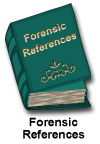|
|
 |
The
required readings for this unit are:
 Australia
Australia |
Required
Reading(s)
|
 |
New Zealand
Brinded, P. M. J., Simpson, A. I. F., Laidlaw, T. M.,
Fairley, N. & Malcolm, F. (1999). Prevalence of
psychiatric disorders in New Zealand prisons: A national
study. Australian & New Zealand Journal of Psychiatry,
35(2), 166-173. Retrieved December 12, 2002, Academic
Search Premier database:
http://search.epnet.com/direct.asp?an=4591236&db=aph
- Note:
The paper describes the methodologies and results
obtained on a large cohort of prison inmates
in New Zealand who were screened for psychiatric
disorder.
|
 Canada
Canada |
Required
Reading(s)
|
 |
Insert article
here
 International
International |
Required
Reading(s)
|
 |
Fioritti,
A.., Melega, V., Ferriani, E., Rucci, P., Scaramelli,
A. R., Venco, C., & Santarini, F. (2001). Crime
and mental illness: An investigation of three Italian
forensic hospitals. Journal of Forensic Psychiatry,
12(1), 36-51. Retrieved December 20, 2002, from the
Academic Search Premier datbase: http://search.epnet.com/direct.asp?an=4422987&db=aph
- Maximum-security
forensic hospitals, or Ospedali Psichiatrici
Giudiziari (OPGs), are the only facilities in Italy
providing care and custody for mentally ill offenders.
This article aims to describe clinical, criminological
and psychosocial features of their population. The
method was an assessment of 118 patients admitted
to three forensic hospitals and a
matched control group from community non-forensic
services. Of the subjects, 72% had a diagnosis
of non-affective psychosis, and 75.2% had committed
serious crimes against other people; 54% of these
crimes were homicide or attempted homicide. At the
time of committing the index crime, 60% were being
treated by a community service, and 68.9% had been
compulsorily admitted previously. OPG inmates more
frequently had a history of substance abuse, had
committed more crimes and had lower social disability
than controls. The needs and problems of this population
seem quite specific and often fall beyond the scope
of ordinary psychiatric services. The project was
funded by the Regione EmiliaRomagna and by the Istituto
Superiore di Sanità
|
 United Kingdom
United Kingdom |
Required
Reading(s)
|
 |
Melia, P., Moran,
T. & Mason, T. (1999). Triumvirate nursing for personality
disordered patients: Crossing the boundaries safely. Journal
of Psychiatric and Mental Health Nursing, 6, 15-20. (from
Proquest database).
- Note the
definition of triumvirate nursing.
 United States
United States |
Required
Reading(s)
|
 |
Broughton,
N. & Chesterman, P. (2001). Malingered psychosis.
Journal of Forensic Psychiatry, 12(2), 407-422.
Retrieved December 20, 2002, from Academic Search Premier:
http://search.epnet.com/direct.asp?an=5180675&db=aph
- The
diagnosis of mental illness is heavily reliant on
both the honesty and the accuracy of patient statements.
Traditionally the veracity of such statements has
been assumed; however, particularly in the forensic
field, such an assumption may often prove to be
naive. The case-example that follows concerns a
man convicted of indecently assaulting a teenage
boy. He presented to forensic services
with a variety of psychotic symptoms, which were
subsequently proven to be feigned. The case exemplifies
certain typical features of malingered psychosis
as described in the American literature; however,
it is also unusual in a number of ways. It serves
to demonstrate that the careful assessment of possible
malingering is a fundamental issue for all psychiatrists,
especially where the therapeutic alliance may be
complicated by external sociolegal issues which
could possibly serve as motivation for the fabrication
of psychopathology
Watson,
J. P. (2002). The differences in perceived burdens
between forensic and non-forensic caregivers of individuals
suffering from schizophrenia. Journal of Mental
Health, 11(4), 375-388. Retrieved December 12,
2002, from Academic Search Premier databse:
http://search.epnet.com/direct.asp?an=7210290&db=aph
- This
paper examines the burdens experienced by caregivers
of people with schizophrenia. In-depth interviews
were undertaken with 107 caregivers (79 caregivers
of clients with a forensic history
and 28 caring for non-offenders) and categorised
into burden dimensions using content analysis. The
severity of the burdens faced was also recorded.
The types of burden experienced by the two groups
were examined using chi squared and t-tests. Results
indicated that the two groups described a similar
number of burdens. However, the forensic caregivers
were more likely to describe burdens relating to
violent incidents and annoyance, particularly towards
services. In addition, they were more likely to
document more severe burdens. The main burdens described
are discussed and recommendations are made for the
ways in which health professionals could assist
caregivers in dealing with the burdens they face.
|
Databases
For the full text article online,
sleuth the 'University
of Calgary/ Library/ Article Indexes':
Directions:
- Select
- Indexes and abstracts with links to full text articles
- Select
- Academic Search Premier or Expanded Academic ASAP
- Select
- Connect
-
Fill in
User ID and Pin
- Fill
in search words:
mentally ill and offender
Top of Page
|
 |
 |
The
'recommended only' readings for this unit are the following:
 Australia
Australia |
Recommended
Reading(s)
|
 |
Insert article/book/chapter
here
 Canada
Canada |
Recommended
Reading(s)
|
 |
Arboleda-Florez,
J., Holley, H. & Crisante, A. (1998). Mental illness
and violence. International Medical Journal, 5 (1),
3-8.
- Note this
study commissioned by the Mental Health Division of Health
Canada to determine if mental illness causes violence.
 International
International |
Recommended
Reading(s)
|
 |
|
Netherlands
Koeter,
Ch. M. W. J. (2002). Quality of life in forensic psychiatry:
An unreclaimed territory? International Review
of Psychiatry, 14(3), 198-202. Retrieved December
12, 2002, from Academic Search Premier database:
http://search.epnet.com/direct.asp?an=6998196&db=aph
- This
article focuses on the role of the quality of life
concept in forensic psychiatry and the aim
is to find out whether quality of life is regarded
as an important outcome measure in this subspecialty
of psychiatry. To this end, a brief description
is given of how the quality of life-concept is dealt
with in general psychiatry and what the status of
the 'quality of life' concept is in the forensic
psychiatric field. One of the major conclusions
is that the operationalization and measurement of
quality of life in forensic psychiatry is
still in its infancy: there are only a couple of
publications pertaining to theoretical and/or empirical
issues of quality of life for mentally disordered
offenders. Therefore, much can be gained from the
experience and knowledge in general psychiatry
and medicine.
|
 United Kingdom
United Kingdom |
Recommended
Reading(s)
|
 |
Gukhool,
D. (2001). Forensic Nursing and Multidisciplinary Care
of the Mentally Disordered Offender. (book review)Journal
of Psychiatric & Mental Health Nursing, 8(4),
376-377. Retrieved December 12, 2002, from Academic
Search Premier database: http://search.epnet.com/direct.asp?an=4862216&db=aph
- Reviews
the book 'Forensic Nursing and Multidisciplinary
Care of the Mentally Disordered Offender,' by David
Robinson and Alyson Kettles.
Moran, T. & Mason, T. (1996). Revisiting the nursing
management of the psychopath. Journal of Psychiatric
and Mental Health Nursing, 3, 189-194.
- Note
this paper contributes a theoretical foundation
to the practicalities of nursing this particularly
difficult patient group, based on clinical experience,
and offers a nursing perspective to the complexity
of the debate (Moran & Mason, 1996, p. 189).
Norman,
I., & Clarke, L. (1998). Forensic psychiatry for
health professionals working with the mentally disordered
offender. Journal of Psychiatric & Mental Health
Nursing, 5(3), 241- 243. Retrieved December 20,
2002, from Academic Search Premier database:
http://search.epnet.com/direct.asp?an=5730535&db=aph
- Reviews
books on psychiatric and mental health nursing.
'Forensic Psychiatry for Health Professionals,'
by Chris Lloyd; 'Working with the Mentally Disordered
Offender in the Community,' by Philip J. Vaughan
and Douglas Badger.
|
 United States
United States |
Recommended
Reading(s)
|
 |
Insert article/book/chapter
here
Top of Page
|

|
Additional
references for this unit can be found in 'forensic
references'
of the forensic sourcebooks.
- Sleuth
'forensic reference' database for:
Mentally ill - offender
Top of Page
|

|
 |
Video's
recommended for this unit are:
|
|
Resources
(Video)
|
 |
Recommended Only
Arboleda-Florez,
J., Crisanti, A. & Holley, H. (1996).Video & Manual
'The police officer as a primary mental health resource'
[90 minutes] Prepared under The Auspices of the Pan-American
Health Organization, by the Department of Psychiatry, Peter
Lougheed Centre, Calgary Regional Health Authority, World
Health Organization Collaborating Centre for Research and
Training in Mental Health.
- Note in the
first section an overview is provided on the impact of
mental conditions, their extent and costs as well as a
general introduction to syndromes, diagnosis and symptoms
of most frequent mental disorders.
- The second
section applies the knowledge that was gained in the first
section to assess vignettes of police-citizen encounters.
- Finally,
the third section deals with general issues of stress
and other factors that could cause individuals, citizens
and police officers to react in an unusual manner to stressful
situations at work or in their private lives (Arboleda-Florez,
Crisanti, & Holley, 1996, p. 67).
Top of Page
|

|
 |
The
required websites to sleuth for this unit are the following:
 Australia
Australia |
Resources
(Web)
|
 |
Mullen, P. E.
(2000). Mental Health and Criminal Justice: A Review
of the Relationship between Mental Disorders and Offending
Behaviours and on the Management of Mentally Abnormal Offenders
in the Health and Criminal Justice Services. Criminology
Research Council. Retrieved June 14, 2002 from http://www.aic.gov.au/crc/reports/mullen.html
- Note this
report written by a professor of forensic psychiatry at
the Victorian Institute of Forensic Mental Health, Victoria,
Australia.
Office of the
Public Advocate (2000) Mental Health Act 1993- Introduction,
South Australia. Retrieved June 18, 2002 from: http://www.opa.sa.gov.au/d3ia.htm.
- The Mental
Health Act 1993, in South Australia defines mental illness
as 'any illness or disorder of the mind' (Office of the
Public Advocate, 2000).
- Note The Act
provides for the treatment and protection of persons who
have a mental illness.
- Note in South
Australia the Mental Health Act 1993 was assented to on
27 May 1993 and came into operation on 6 March 1995.
Office of the
Public Advocate, South Australia.(2002) Retrieved June 24,
2002 from: http://www.opa.sa.gov.au/index.htm
- Note - Consent
to medical and dental treatment for persons with reduced
mental capacity.
New South Wales
Consolidated Acts. (2000, April). Mental Health Act 1990,
NSW Consolidated Acts. Retrieved June 17, 2002, from: http://www.austlii.edu.au/au/legis/nsw/consol_act/mha1990128/
- Note the
New South Wales, Mental Health Act of 1990, specifically
Part 2 Review of Forensic Patients and Part 3 Provision
for Forensic Patients.
 Canada
Canada |
Resources
(Web)
|
 |
Alberta - Government
of Alberta. (2002). Mental Health Act. Alberta Statutes
and Regulations. Queens Printer. Retrieved July 5, 2002
from: http://www.qp.gov.ab.ca/Documents/REGS/1989_309.CFM
- Note the
Mental Act of Alberta came into force Regulation, except
section 4(2), comes into force on January 1, 1990.
- Note the Designation
of Services, specifically Forensic services under the
Act.
Alberta Heath
and Wellness. (2002). Alberta Key Initiatives - Health Information
Act. Alberta Health and Wellness Retrieved July 5, 2002
from: http://www.health.gov.ab.ca/key/keyhipa.htm
- The new Health
Information Act was passed on December 8, 1999 in the
Alberta Legislature. This legislation will ensure that
the rules about the collection, use and sharing of health
information are clear to all Albertans.
- The new Act
is designed to build on the way that the health system
works today but will make certain that there are adequate
safeguards in place. Custodians, who are the people responsible
for maintaining and protecting health information, will
explain to individuals why certain information is being
collected. People will be asked to give their consent
before their health information can be disclosed for certain
purposes.
Alberta -Government
of Alberta. (2002). Health Information Act. Queens
Printer. Retrieved July 5, 2002 from http://www.qp.gov.ab.ca/Documents/acts/H05.CFM
- Note that
the Alberta Health Information Act was proclaimed in force
on April 25, 2001.
Arboleda, J.
& Holley, H. & Crisante, A. (1996). Mentally
Illness and violence: Proof or stereotype? Calgary World
Health Organization Collaborating Centre for Research and
Training in Mental Health, For Health Promotion and Programs
Branch, Health Canada. Retrieved July 2, 2002 from
http://www.hc-sc.gc.ca/hppb/mentalhealth/pubs/mental_illness/
- Note this
study commissioned by the Mental Health Division of Health
Canada to determine if mental illness causes violence.
Long, P.W. (1995-2002).
Internet Mental Health. Retrieved July 5, 2002 from:
http://www.mentalhealth.com/toc.html
- Note that
this website is a free encyclopedia of mental health information.
Their hope is that Internet Mental Health will promote
improved understanding, diagnosis, and treatment of mental
illness throughout the world.
- Note the
link to 52 most common mental disorders including: description,
diagnosis, treatment, and research findings.
- Note the
link to 67 most common psychiatric drugs including: indications,
contraindications, warnings, precautions, adverse effects,
overdose, dosage, and research findings.
- Note that
this site does not accept take funding from corporate
sponsors and why.
 International
International |
Resources
(Web)
|
 |
Insert website
here
 Switzerland
Switzerland |
Resources
(Web)
|
 |
Sartorius, N.
(2002, June 22). Iatrogenic stigma of mental illness [Editorial]
Professor, Department of Psychiatry, University of Geneva,
Geneva, Switzerland, BMJ, 324, 1470- 1471. Retrieved June
24, 2002 from: http://bmj.com/cgi/content/full/324/7352/1470.
- Note the British
Medical Journal is an excellent online journal.
 United Kingdom
United Kingdom |
Resources
(Web)
|
 |
Department of
Health (1999) Reform of the Mental Health Act 1983 Proposals
for Consultation. Department of Health United Kingdom. Retrieved
June 17, 2002 http://www.doh.gov.uk/mentalhealth.htm.
- Note the
Mental Health Act of 1983 is being reviewed for reform.
Home Office.
(2002) Draft Mental Health Bill. Department of Health http://www.doh.gov.uk/mentalhealth/draftbill2002/index.htm.
- Note that
the Government's proposed reforms to the 1983 Mental Health
Act have now been issued and consultation is open until
16 September.
Walton, M. (2002).
Mental Health Laws, Mental Health and Related Matters Retrieved
June 17, 2002 from: http://www.markwalton.net/.
- Note the link
to the Mental Health Act online from this site.
 United States
United States
|
Resources
(Web)
|
 |
Surgeon General
Report on Mental Health. (1999, Dec 14). Mental Health:
A Report of the Surgeon General by David Satcher, M.D.,
Ph.D. Retrieved June 14, 2002 form http://www.surgeongeneral.gov/library/mentalhealth/
- Note this
comprehensive new report on Mental Illness in America
Top of Page
|
 |
For
additional websites on this unit, sleuth 'forensic
websites' in the forensic sourcebooks.
Top of Page
|
 |
|